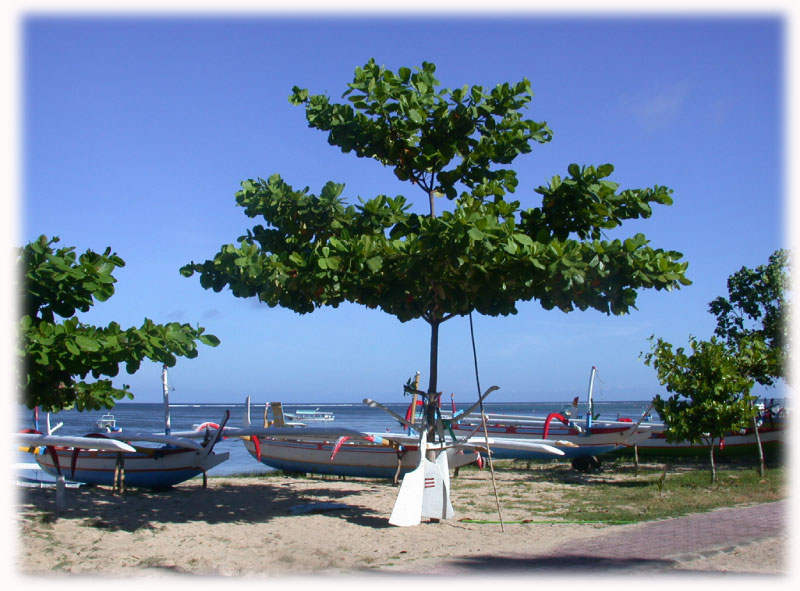
A typical Tropical Almond in a typical setting. Photo by Tropical Plant Book
I went to Ft. Myers one Friday to look at plants on an 11-acre monastery. On the property there was a large tree they didn’t know nor did I. The following Sunday while teaching a class across the state in West Palm Beach two students knew a tree there that I didn’t know. It was the same tree at the Monastery. Small botanical world. The tree was a Tropical Almond.
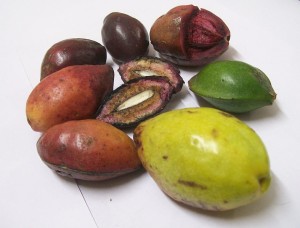
Tropical Almonds at various stages of ripening. Photo by Staticd.
You would not know the Tropical Almond is not native to the American tropics if you judged it by popularity there. Starting in mid-Florida along the coast then south it becomes more common if not excessive by Central America. Not bad for a tree that is native to East Indies and related warm areas from Australia to Africa. It’s usually found in coastal locations because it likes low-elevation (under 1300 feet) and is salt, drought and wind tolerant. Add a lot of rain and no freezes and the tree is happy. It’s often used in landscaping because when a leaf dies it turns red making the tree colorful most of the time. The journey west to east probably started in Hawaii. We know it was there before 1800. It was definitely introduced to Jamaica by 1790. The tree is naturalized in southern Florida, the Florida Keys, Virgin Island and Hawaii as well as the West Indies and from Mexico to Peru and Brazil. It is also grown in warm areas of Texas and California
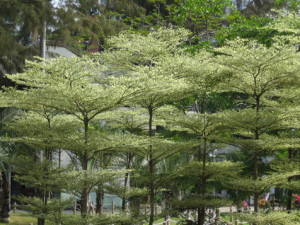
Pagoda-like Terminalia mantaly “Tricolor” in Hong Kong. Photo by Green State
Botanically Terminalia catappa (ter-mih-NAIL-ee-uh kuh-TAP-uh) it is not related to the edible almond. No doubt the tree gets it common name from the seed pods which look like large unshelled three-inch almonds and from the seed/kernel which resembles almonds. Unlike true almonds though the outside of the fruit is also edible. Both the seeds and the fruit of this particular species are edible raw. When the fruit dries it is very light thus buoyant and uses water (ocean currents) to get spread around. They are a common “sea bean” found along Florida beaches. For such light fibrous things they are surprisingly tough to open (especially if you have only two chunks of small concrete as we did that day… the surface of Florida does not have rocks.) Julia Morton, who was a long-term botany professor at the University of Miami, reported in 1985 that “defleshed, thoroughly sun-dried fruits may be readily cracked by a sharp blow on the keel.” If well-dried they will also open if hit on the end point with a hammer.
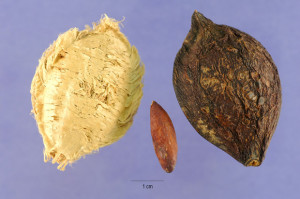
Inside the Almond-like husk is a tasty kernel. Photo by N.I.T. Gallery
Propagated by seed the fast-growing Tropical Almond reaches 30 to 55-feet talls on average but can grow to 80 feet. Deciduous, it forms a symmetrical, upright tree with horizontal branches that reach 35 feet in width. The branches are arranged in tiers giving the tree a pagoda-like look. The tree’s large leaves are distinctive, 12-inches long and six-inches-wide, glossy green, leathery with a heart-shaped base. They are also woolly underneath and grow in a rosette at the end of branches. Leaf stems have two glands at the upper end. Before dropping from age, or winter or drought they change through shades of red, yellow, and purple. Spring time blossoms are inconspicuous, green and white, arranged in fives with 10 to 12 stamens each all on six-inch-long terminal clusters. They produce the edible fruit that changes through the colors already mentioned for the leaves: green to yellow then red or dark purple. The husk is corky, thin with green flesh inside. The fruit is high in tannic acid which can stain cars, pavement and sidewalks. But the tannic acid is also good for tanning hides. Interestingly the tree does not attract much wildlife. Some tropical ants like it and fruit bats eat the husk. Bees are attracted to the blossom but apparently have a difficult time making honey from them. Humans can barely detect an odor from the flowers. A tree can produce (when shelled) about 11 pounds of kernels per season.
There are some 250 species in the Terminalia genus. Terminalia is a variation of the Dead Latin word Terminus, a Roman God who presided over boundaries and frontiers. He liked fences and was never inside a buiding. In English we get termination, terminal and terminus from it. Here Terminalia refers to the rosette of leaves at the end of branches. While I would like to say Catappa is from the Greek word Kata (which means “below, all along” ) it is not. Catappa is variation of the Malaysian name for the tree which is ketapang.
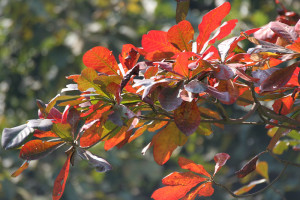
Whether by age or conditions Tropical Almond leaves turn red making attractive foliage. Photo by J.M. Garg.
For flavonoids the tree has quercertin and kamferol; pigments include violaxanthin, lutein and zeaxanthin; tannins are punicalin, punicalagin and tercatein. The leaves and bark are astringent. Medicinally the tree has had a myriad of uses in folk medicine including treatment for cancer, sickle cell disorders, dysentery, cough, leprosy, nausea, diarrhea, intestinal parasites, eye problems, rheumatism, colic, liver disease, scabies, upset stomach, thrush and as an antibacterial agent and contraceptive. There is some modern research that suggests it might be useful in treating high blood pressure. Leaf extracts have shown to have some anti-diabetic and antioxidant activities. The leaves and bark are put in fish tanks to increase water acidity and reduce bacterial infections amongst the tank’s inhabitants.
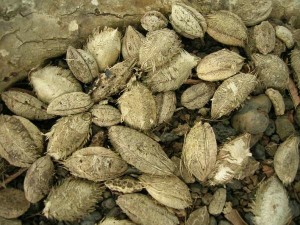
Dried fruit floats and is carried thousands of miles by ocean currents. Photo by N.I.T. Gallery
The wood is moderately dense but had not been used for timber like other Terminalia species. It’s hard, strong, and has an attractive heartwood. Boxes, crates, buildings, bridges, boats, floors, planks, wheelbarrows, carts, barrels and water troughs are made from the wood. It does not do well in soil such as when used as fence posts but does well in water such as for building boats. In Fiji and Samoa it is the favorite wood for native drums.
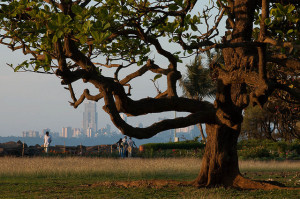
A Tropical Almond Tree in India. Note the shallow roots, one reason why it grows well in south Florida which in many places only has a few feet of soil on limestone. Photo by Barbara E.
Related species that have edible kernels after washing and cooking are T. glabrata, T. litoralis, T. mauritiana, T. pamela, and T. kaernbachii, the latter of which has seeds that are 12.5 protein and 70% fat. Morton reported T. cattapa kernels are 52% fat, 25.5% protein and 6% sugar. The oil is mostly palmitic acid, 55.5% and oleic acid, 23%. Per 100 grams the outer flesh is 74% moisture, 5% protein and has 84 mg of calcium, 24mg of phosphorus, 7 mg iron, 21 mg of ascorbic acid. The T. cattapa is the only one in the genus to produce a kernel that can be eaten raw and does not need washing or cooking. A few species produce lesser quality fruit whose fleshy husks (but not seeds) are eaten: T. edulis, T. oblongata, T. platyphylla, T. sericocarpa, and T. solomonensis. The seeds of those species are often not eaten because of a high tannic acid content sometimes as high as 53%. Whether they can be leached like acorns I do not know. I suspect if they could it would have been discovered by now.
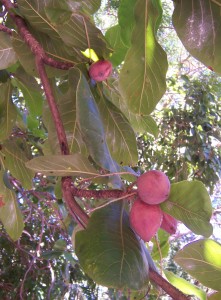
Tropical Almond fruit ripening. Photo by B. Navez
Other names for the species include: Barbados almond, bastard almond, Bengal almond, country almond, Demarara almond, false kamani, Fijian almond, Malabar almond, Malay almond, sea almond, Singapore almond, story tree, tavola nut, West Indian almond, alconorque, almendrillo, almendro, almendro de la India, almendron, almendro del pais, amandelboom, amandier de Cayenne, amandier des indies, amandier des tropiques, amendoeira, badam, badamier, castafia, castafiola, chapeu de sol, guarda-sol, kalumpit, kamani-haole, ketapang, kotamba, parasol, saori, talie, talisai, tavola, tipapop, tipop, tivi, white bombway, wilde amandel, zanmande, and many more dialect names.
The leaves are also fed to silkworms and animals.
Green Deane’s “Itemized” Plant Profile: Tropical Almond
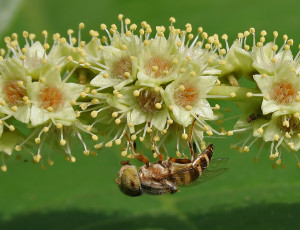
Flowers of the Tropical Almond. Photo by J.M. Garg
IDENTIFICATION: Terminalia catappa: Usually a single trunk tree that can reach 80 feet high, 18 inches through at the base. It has whorls of nearly horizontal, slightly ascending, branches like pine trees eventually taking on a pagoda-like appearance. Branches droop at the tips. Leaves are short stemmed, spirally clustered at the branch tips, obovate, up to 11 inches long, six inches wide, dark-green above, paler beneath, leathery and glossy turning bright-scarlet, dark-red, dark purplish-red, or yellow in midwinter often right at Christmas time in Florida. In Hawaii the tree is evergreen. Foetid flowers are greenish-white, very small, no petals but 10-12 conspicuous stamens, in slender spikes in the leaf axils. Most flowers are male, a few hermaphrodite, some female. The fruit is two inches or more long, one inch or more wide. Most that I’ve seen are about three inches long and half as wide, ellipsoid more pointed at the end than at the base, slightly flattened, with a prominent keel around both sides and the tip. Skin is smooth, waxy, and thin. Pulp layer is juicy, whitish to pink or reddish, slightly sweet or acidic. The seed in the husk is spindle-shaped with a thin brown covering. The “kernel” is actually the tightly coiled seed leaves of the embryo, more tender than an almond with a hazel nut like flavor.
TIME OF YEAR: Varies on location, summer, winter or nearly all year. Here in Florida they bear in November. In southern Indian they have two crops per year. In the Caribbean they fruit continuously.
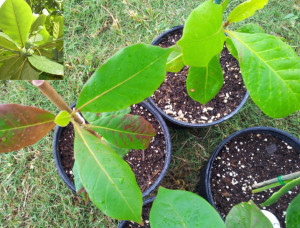
Young Tropical Almonds in pots. Photo by Tropicals USA
ENVIRONMENT: Full sun to medium shade on well-drained soil, tolerant of wind, salt, and drought, likes being mulched and regularly fertilized. Will not tolerate freezes. The germination rate for whole fruit is 25%. Seedlings are transplanted into pots and raised in shade slowly acclimatizing them to full sun. Field planting is done when they are seasonally leafless.
METHOD OF PREPARATION: The fruit has a pleasant aroma but is not too tasty. The ripe husks of the fruit can be eat raw but are best when young and sweet. The seeds have an almond or hazel-nut flavor. In India they are often served sitting in water on a small plate. The oil can also be used for cooking or to make soap. Leaves can be used as plates or to wrap small amounts of food. Among the fruit there can be a lot of variation as to when they are edible and palatable, sometimes when younger other times when older.
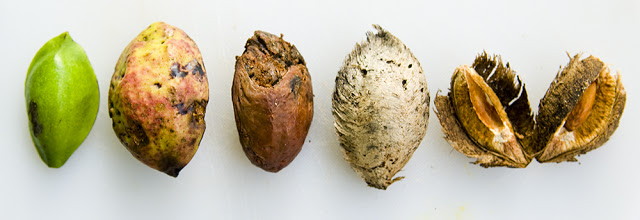
Tropical Almond Fruit. Photo by The Three Foragers

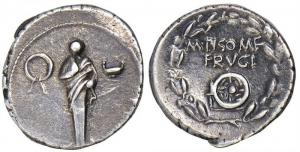

have to look for that one
There is a sentence regarding T. Catappa, which reads: “The T. cattapa is the only one in the genus to produce a kernel that can be eaten raw and does not need washing or cooking”. I know two others species of terminalia that the kernel can be eaten raw; they are T. Kaernbachii and T. Calamansanai. The later is not appealing to fetch because it has very small fruits but the T.Kaernbachii is bigger than T. catappa and their test are amost the same…very appealling!!
thanks.. clearly local opinions differ.
being from Central America (Honduras) and having eaten both these and store bought almonds, I thought that they were the same. today I saw a picture of real almond and the leaf was totally different from the big round leaves on the tropical almond. my mind was blown!! thanks for the article it is an interesting read.
When I lived in island Margarita in 1978, I learned to eat those almonds from other kids. We would eat the flesh of those with great colors. Some trees would give more yellow ones, some more pink red. They were delicious, strange, sweet taste. Then, we would collect those dried up on the floor crack them with stones to eat the almond! Huuuum, what a souvenir!
Growing up in Puerto Rico, our next door neighbor had one in front of the house. I never ate the fruit, if I recall corectly it was the same as eating a not totaly ripe wild perssimon. We did spend a lot of time scraping off the fruit on the sidewalk until we had a goodly number of kernels that we would bust open with a hammer. Good memories, good time. Sadly my zone would not allow me to try and grow one.
is the sprout of the indian almond good to eat ?
I have no reference to that.
Natural Island Almonds are Good Eats. I’m from the Virgin Islands & These Trees are All Over the Island. When I was Smaller we use ot Collect a Ton of these for our Eating Pleasure lol Sometimes I jus use to eat them Plain, its Sweet & Tart but dats if you get a Really Good one lol We Also use to Take the Meat off of the Fruit & Stew them in a Pot wit Water Sugar & Vanilla until they were Soft Sticky & Sweet. Then we would Save the Seed, allow it to Dry Out for about 3Days in the Sun then Crack it Open for Delicious Almonds inside in which we use to Bake in the Oven. Good Times. I’m glad I Found this Page, I was jus Browsing around & Lookin for Local stuff, this was a Good Read.
Ha Ha! Crazy Idea jus came to my Mind. Wouldn’t it Be Great if Cruzan Rum Made Amaretto Liquor from this Almonds! They have these Fruit all over the Islands in Abundance & it seem lik a Easy Transition to me. I could Taste it Now lol The Worlds Greatest Rum Combined with its Locally Grown Fruit to Created one of the Worlds Favorite Liquors. I think this would be a Big Hit throughout the Carriben if they did this. Everyone Loves Amaretto so why not make it? They hav all the Stuff they Need. (Please Cruzan Rum Read this Lol)
Thanks for the article. We have some growing on/near the beach here in western part of Panama (Pacific side). One of the locals cracked a seed open for me last year using two rocks; they were scattered around from a nearby tree and I liked it. Discovered one beginning to grow near to one of the coco palms I planted several years ago and since it’s too close, I want to transplant it to a better location. It’s in the sandy soil. Can it be moved a little further from the beach? I’d like it to be in a sunny place with lots of space to grow, but the beach area is dense with other trees, thus a spot away from where it is now. Any tips for doing so successfully?
Yes, they can be moved inland. I know of at least one tree that is a good 10 miles from the shore.
I live in Hyderabad, India which is 250 miles from the coast, and these trees are everywhere. So yes.
Can the nut be used to make almond milk? The bats in my yard have a field day with the pulp and drop scores of seeds. I have tried to harvest whole nuts but to smash the shell all you get is bits. Hoping to collect enough to make an couple cups of milk.
If you crack them on the end while holding them up they open better and destroy less. While they are edible I don’t know if they would disintegrate enough to make a milk. I’ll have to try.
DEAR SIR THE WRITER OF THIS ARTICLE MAY I KNOW
WHAT ARE THE REFERENCES OF THIS THIS ARTICLE?
YOUR RESPONSE WILL BE HIGLY APPRECIATED THANK YOU.
I usually use the journal of Economic Botany.
Hi Green Deane,
One related species you did not mention in T. ferdinandiana which is an edible fruit known as the Kakadu or Kalari plum. It is the world’s highest fruit source of vitamin C and is rich in elagic acid, gallic acid, folates, Cu, Fe and Zn. It is still wild harvested by Australian Aborigines today who supply companies like mine and I supply food, nutritional and cosmetic companies with fruits, purees, extracts and freeze dried flesh.
Great article. Thanks.
Hi Vic..I am living in Pilipinas now,and am observing the vegetation around me(and eating a fair bit too!).
I am at this web-site to perhaps ID some of the “weeds'” I collected today..and learn of their value or otherwise.
I met you and the Family a few times around the Manning when I lived and worked in the area.
You had land and a plant business closer to Lauriaten,i think,and were good friends of the Richardsons in Mt. George.i lived near Mondrook with Jane and the two boys(“Boobook’).
i cut out the few Terminalia i had grown from seed here,as they were too vigorous and threatening to be too big for our 80 sq.M!!
However,I may now collect some “fruit” locally,and try them for the taste…??
I was surprised that the Kakadu Plum was related,and also pleasantly surprised to see your post and name.
you may not ever read this..but worth a try..best wishes to you and the Family.
Hi Neil,
Lots of water under the bridge. I hope that life is good for you in the Philippines. My wife Clare and I are living the dream on the Northern Beaches of Sydney, battling population growth and stupid developers (pardon the oxymoron).
Check out the website and please stay in touch.
Cheers,
Vic
Very interesting, We have a couple of these trees in Antigua where they grow well and fruit all year. We were looking up the tree to find out if they could be pickled? The fruit bats love them but make a real mess! Like the idea of flavouring rum!
Colin.
Moved from NYC to S. Florida 3 1/2 yrs ago. There were two small trees on my small property just outside and smaller my screened enclosure. 3 1/2 yrs later they tower over the house. It’s growth rate has me concerned but less so since it seems the roots like to work around obstructions rather than destroy. Worried about pipes. Also, “wind tolerant”, does that mean they are pretty sturdy during hurricanes are should I continue to cut away the tops and keep them from getting taller? Did store large pieces in attic to dry and then use for wood. Seemed quite hard to work with and the dust flew like dry wall dust instead of dropping like most woods so I do not use it for wood projects. Shame, it yields a lot of wood.
Does anyone know where I can find an almond plant or seeds
I shall send it to u
Could I have some too!
I live in Okinawa…these trees do well in typhoons..this last really strong typhoon they lost their leaves, but not branches..the leaves all grew back..like fresh spring..in October..the goats here, caged very few farm animals..love to eat these leaves, that is why I was looking on this site. And it had that one comment..leaves fed to silk worms and animals..so good. I am not poisoning them..not that I think a goat..pretty smart would eat something harmful.
Here in Honuras, I have 5 of these trees that are growing very quickly. Today I noticed that only one tree has small reddish spots in a line almost to the edge of each leaf. Could this be a way to identify a male or female tree?
Also called Chepéu-de-praia and Sete Copas.
Is it safe to eat freshly cut leaves? I’ve made a lot of tinctures with them and I’d like to know if I was supposed to use the brown fallen leaves and not the green ones.
Please does anyone know where I can find almond trees. . I would like a few please.
geeyia@aol.com
I live in American Samoa and many folks use the tree as medicine: the leaves, the bark, the fruit, etc.. Have you found this true in your research? I’m helping a student in my 8th grade class do a science project and don’t quite know where to start…any suggestions would be greatly appreciated.
thanks for the article
What is the focus of the science project? For example, the species is invasive which ties in with a new theory that invasive species are more biologically diverse.
I planted a seed given to me by a friend. It germinated up North and I planted it here in Florida. In 8 years it has grown about 35′ tall. However the fruit is black, seems fleshy, and is only about 1″ long. Fruit is everywhere and some germinate in the ground. Is this a “weed” variety of the tropical Almond or does it have some value?? Is it worth the bother to try and see if there is a “nut” inside?? And would it be edible??
Are you sure it’s a tropical almond?
are the kakadu plums and these tropical almonds the same?
No, the are relatives. The tropical almond is Terminalia catappa. The Kakadu plum is Terminalia ferdinandiana.
Thanks for the infos on the tropical almond tree and it s fruit, please can you refer me to the machine that can break the husk to get the kernel/nut out of the dry seed . Thanks I. Advance for tour assistance.
.I recently cane upon your question regarding the sourcing of a .a machine that could break the tropical almond.
If you were successful in getting the answer to your question, would you be kind enough to share that information?
I am Interested in purchasing one of those as well.
Many thanks.
Desmond
I’m from st Lucia and we would find tons of these alomondvplaces that doesn’t have almond trees,…growing up i was told they were carried by bats…jus found it a little strange that u would some times find them by the dozens …so i was wondering if their was another explanation ???
Hello I live in USA however I am from Jamaica West Indies were these Almonds are all over the island I would I have yet to come across a machine that can conquer the Indian Almond if anyone has one or knows were one can be purchased PLEEEEASE contact me ASAP at perfectfit365@gmail.com I will pay big bucks for it. Thanks.
I live in Fort Lauderdale Fl. Soon to be moving to Palatka Fl. To start a small 2 acre farm. There are a lot of These trees here but i would like to know if they grow there in zone 9b. I have eaten the raw almond seed and am excited to try the fruit when they ripen again now that i they are edible. I have some friends from Haiti that told me the young leaves that look shiny are edible raw. I tried a little piece and it was ok yet fuzzy pin bottom. They also said on a hot day they put the young leaves in their hats on their foreheads especially all day and it lowers your temperature. They said the purple fruit is sweet and the yellow not sweet at all. They also use them for medicinal purposes.
Hi mike. I live in Delaware state. I saw your post that you have farm and has this trees. I would like to visit your farm if you still have this trees. please contact kirtan29@gmail.com 410-212-0908.
Hello folks, I’m in south Florida, and I have this tropical almond tree in my yard. On Facebook (in one of the gardening groups) some say do not eat the almonds and some say I can eat the almonds
Well I’ll be safe and not eat them
This tree grows very very fast. I have trimmed it 10 times in 4 years because it’s close to my roof and the branches are too close where the leaves blow into the rain gutters and onto the roof
Are you near West Palm Beach? I have a class there and there is a fruiting Tropical Almond there. I will prove in person the seed inside is edible.
I have one of these tropical almond trees in back yard. It grow so fast in central Florida. I want to prune it way way down, and just leave main trunk and major branches, What will happen if I do this? I don’t want to kill the tree though.Will it still grow out horizontal branches with new growth, and what is the best time of year to prune? Thank you in advance to whoever answer this…
i would like to purchase fruits from that tree. please let me know if somehow you can ship to Delaware state. please contact kirtan29@gmail.com
I have one in my front yard, in Los Cabos, Mexico, I have pruned it into a canopy, so it gives shade over my outdoor dining table, so instead of the pagoda effect, I have topped off the top to keep the tree around 12 ft tall, everyone admires it, even the guy from the Garden Centre.
I have a seed which has a green shell. Am I able to plant it directly like that or do I need to remove this covering.
You can plant it as is.
I am Hemant from India who purchased green almond seed (row seeds)
Any query’s please tel me I am row materials shellers.
Hello and thanks for this, what is the easiest way to process and remove the nut from its thick shell? I heard it was too difficult … I live in an island off the coast of Honduras where these trees are abundant on our property
They wear down naturally until the look like an unshelled almond. Turn them on their side and hit them with a hammer or rock until you hear a crack.
Regarding Terminalia Kaernbachii or Okari Nut- I am growing 4 from seed and according to http://tropical.theferns.info/viewtropical.php?id=Terminalia+kaernbachii the nut kernel may be eaten raw, roasted or baked. The fruits were the size of my 2 fists put together and that was mostly seed. I got mine from Govardhan Gardens.
I am wondering how I can grow this tree from seed. Should I take some of the casing off? how wet should I keep the soil etc. Any info you can give would be appreciated!
No just bury the entire fruit a few inches down.
Sir, I would like to have that almond nut
I have a beach almond seed its green do I have to dry it out before planting open it or just plant it now
You can just plant it.
Great website. I kept one of these seeds as a souvenir from Hawaii, planted it an now have a small seedling. I was wondering what it was and how large it would grow…now I know. I guess I have a house plant as it won’t survive a Canadian winter. Thank you for the information.
Pls can almond fruit be used as an enhancer for sexual purposed someone recommend it how true could these be medically.reply
To quote this study:he kernel of T. catappa seeds has aphrodisiac activity and may be useful in the treatment of certain forms of sexual inadequacies, such as premature ejaculation.
https://www.ncbi.nlm.nih.gov/pubmed/11225980
please help me with any information on terminalia mentaly tricolor
We are planting up to 100 acres of tropical almond coconut intercropped with seedless limes and cocoa. We have a hand cracker designed that local machine shop is making and a motor driven cracker due within the month We would like to sponsor small village farmers to plant cocoa under the almond and coconut shade Need help getting a crowd funding project going Have good local sales to tourism for the organic cocoa we found in the jungle and the use as a health food as is the coconut and almond need participants that can help make it happen I have the trees and market easy to visit in Belize
We plant the tree here in Indonesia. I do love its shape and doesn’t need much effort to clean up the falling leaves since the size of each leaves are large enough. The only problem is that the fruit bats love the fruit as their main course as well as they dropped their waste foods on the ground, in large amounts!
Can I buy tropical almond cracking machine?
please, contact my gmail. Thanks.
Perhaps in Asia where it is a commercial crop but I doubt in North America.
I fell in love with this tree when I was on my honeymoon in Punta Cana, Dominican Republic. I found a 1′ tree that I can buy online, but I am wondering how well it would fare in the west Texas desert. I also am probably moving soon, so I don’t want to plant it in the ground. Forgive my lack of botanical knowledge, but if I place it in a large pot, will it stunt the tree size to be easily moved later? Thank you!
They don’t like frost or such weather. I have to take mine inside when it gets below 32 F.
Great article!
Does anyone ever tried cooking,eating the green leaves or make “tea” subtitute out of the dried leaves to drink?? Im curious to try, but still would feel better if someone already did it xD
Thanks for writing. I would be careful regarding using leaves of the Tropical Almond. It is in the genus Terminalia. A relative, Terminalia bellirica, has been used for treating a variety ailments.
black cockatoos LOVE the fruit.
Great article. Here in Nigeria we simply refer to this plant as fruit. I just recently discovered that it is a kind of almond and I am wondering if i can extract oil from the nuts cos we don’t have the real almonds here. Maybe I should just give it a try.
Were you successful in getting a hand cracker from your local machine shop and did your motor driven cracker arrive? I am part of a group in Puerto Rico that would like to make our local almond available for sale at the farmers markets on the island. Any information would be greatly appreciated!
Hi Alexandra,
I too live in Puerto Rico (Rincon) and am trying to find a machine to process the almonds. They are delicious! But a pain to crack with stones. If I can’t find a machine already designed I am planning to hold a contest with cash prizes for who can come up with the best design. My focus is for families and individuals.
Have you found anything that owrks?
Marjory
I am in New York and looking to buy a Tropical Almond peeling and cracking machine.
Can someone please advise.
Thank you,
DO YOU KNOW HOW ONE CAN IDENTIFY THE TYPE OF TROPICAL ALMOND TREE I HAVE? BY LEAF TYPE?